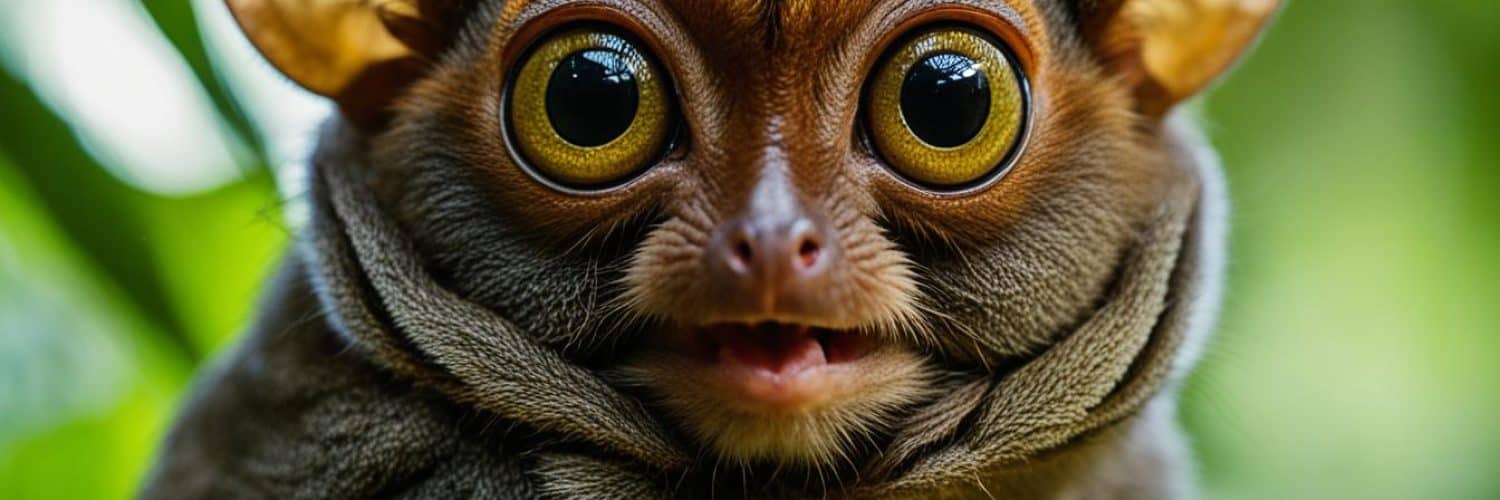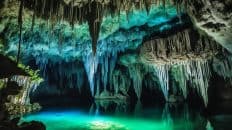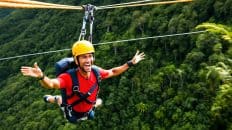The Philippine Tarsier and Wildlife Sanctuary in Bohol, Philippines, is a remarkable destination for nature enthusiasts. It is home to the Philippine tarsier, an endangered species of nocturnal primates. The sanctuary, operated by the Philippine Tarsier Foundation, aims to preserve these unique creatures and promote eco-friendly tourism.
Located in Corella, Bohol, the sanctuary provides a natural habitat for tarsiers, allowing visitors to observe these fascinating animals in their element. It offers a range of facilities, including an exhibition area, cafeteria, audiovisual room, research center, library, and conference rooms, enabling visitors to learn more about the tarsiers and the conservation efforts.
The sanctuary has received rave reviews from 1834 visitors, with an average rating of 4.3. It has become one of the must-visit tourist spots in Bohol, attracting nature lovers from around the world.
Key Takeaways:
- The Philippine Tarsier Sanctuary in Bohol is an eco-tourism destination.
- It aims to protect the endangered Philippine tarsier species.
- Visitors can learn about tarsiers through the visitor’s complex.
- The sanctuary is highly rated by visitors, with an average rating of 4.3.
- Conservation efforts and promoting eco-friendly tourism are the main goals of the sanctuary.
Location and Directions to the Philippine Tarsier Sanctuary
The Philippine Tarsier Sanctuary is located in the picturesque town of Corella, Bohol, in the Philippines. Situated approximately 13 kilometers away from Tagbilaran City and 27 kilometers from Panglao Island, the sanctuary offers a peaceful retreat for wildlife enthusiasts.
To reach the Philippine Tarsier Sanctuary, there are several transportation options available:
- Public Transportation: Visitors can take jeepneys bound for Corella from the Dao terminal in Tagbilaran City. The ride takes around 20-30 minutes, and the sanctuary is easily accessible from the main road.
- Motorbike Rental: For those looking for more flexibility, renting a motorbike is a popular choice. Motorbike rentals are available in Tagbilaran City, and the ride to the sanctuary takes approximately 20 minutes.
- Guided Tours: Joining a guided tour that includes the Philippine Tarsier Sanctuary is a convenient option. Many Bohol countryside tours offer free transfers to and from the sanctuary, making the experience hassle-free.
Upon arrival at the Philippine Tarsier Sanctuary, visitors will be greeted by the serene beauty of the surroundings. The entrance fee enables access to the sanctuary’s grounds, where in-house guides are available to provide valuable insights and assistance.
Entrance Fee:
| Visitor Type | Entrance Fee |
|---|---|
| Adults | PHP 60 |
| Children (7-12 years old) | PHP 30 |
| Children (below 7 years old) | Free |
Visitors can explore the sanctuary at their own pace, immersing themselves in the peaceful ambiance and marveling at the incredible tarsiers. For an unforgettable experience in Bohol, include the Philippine Tarsier Sanctuary in your itinerary and embark on a journey into the world of these captivating creatures.
Best Time to Visit the Philippine Tarsier Sanctuary
While the Philippine Tarsier Sanctuary in Bohol is open year-round, the best time to visit is from December to May. During these months, the weather is cooler, creating a comfortable environment for exploration and observation of the tarsiers. However, it’s important to note that this period can be crowded due to the holiday season and summer vacations.
Plan your visit accordingly to avoid large crowds and ensure a more serene experience with these fascinating creatures. The sanctuary opens its doors at 8:30 AM and closes at 4:00 PM, providing ample time for visitors to fully immerse themselves in the natural habitat of the tarsiers.
Protecting the Philippine Tarsier: Conservation Efforts
The Philippine Tarsier Sanctuary in Bohol plays a crucial role in the conservation of the Philippine tarsier, an endangered species facing numerous threats to its existence. The sanctuary and its partners, including the Department of Tourism and the Department of Environment & Natural Resources, are dedicated to protecting these small primates and their natural habitat.
The Philippine tarsiers are confronted with indiscriminate logging, hunting, the pet trade, and the introduction of invasive species. These factors contribute to their decline and emphasize the urgency of conservation efforts.
To safeguard the tarsiers, the sanctuary implements various measures, including habitat preservation, research, and community engagement. By creating a protected area, the sanctuary provides a safe haven for tarsiers to thrive and reproduce.
Visitors have a vital role to play in the conservation of tarsiers. By visiting the Philippine Tarsier Sanctuary, tourists not only get a chance to see these fascinating primates up close but also contribute to conservation efforts directly. The entrance fees paid by visitors help fund initiatives aimed at protecting tarsiers and raising awareness about their plight.
Additionally, individuals can support tarsier conservation by donating to non-profit organizations focused on protecting endangered species like the Philippine tarsier. These organizations work tirelessly to combat the threats faced by tarsiers and ensure their survival for future generations.
Together, through collective action, we can make a significant difference in preserving the Philippine tarsier and their unique ecosystem.
Quotes:
“Conservation is not a luxury but a vital necessity that ensures the survival of the incredible biodiversity that our planet has to offer.” – Jane Goodall
List of Conservation Actions:
- Creation of protected areas to preserve tarsier habitats
- Research to better understand tarsier behavior and needs
- Community engagement to raise awareness and gain local support
- Collaboration with government agencies and other conservation organizations
- Enforcement of regulations to prevent logging, hunting, and illegal pet trade
- Education programs to promote sustainable tourism practices
Experience the Enchanting Tarsiers of Bohol
The Philippine Tarsier Sanctuary invites visitors to immerse themselves in the enchanting world of tarsiers. Located in the beautiful region of Bohol, Philippines, this wildlife sanctuary offers a unique opportunity to observe these fascinating creatures in their natural habitat while promoting eco-friendly tourism practices.
At the visitor’s complex, you’ll find an exhibition area dedicated to educating visitors about the Philippine tarsier. Discover interesting facts about their behavior, habitat, and conservation efforts through interactive displays and informative exhibits. Get up close and personal with the tarsiers through captivating images and videos that showcase their unique characteristics.
The sanctuary also houses a research center, where experts conduct studies and gather valuable information about tarsiers. Explore the center’s collection of resources, including books, journals, and research findings, to deepen your understanding of these delightful primates. The research center plays a vital role in the sanctuary’s conservation efforts, ensuring the continued protection of tarsiers and their habitat.
More than just a wildlife sanctuary, the Philippine Tarsier Sanctuary is committed to promoting eco-friendly tourism practices. By visiting the sanctuary, you support sustainable initiatives that prioritize the well-being of tarsiers and their environment. Experience the beauty of nature while leaving a minimal ecological footprint, making your visit truly meaningful.
Whether you are a nature enthusiast, a wildlife lover, or simply seeking a unique travel experience, the Philippine Tarsier Sanctuary offers an unforgettable adventure. Witness the enchantment of tarsiers, learn about their conservation, and contribute to the preservation of these marvelous creatures.
Tarsier Facts: Unique Characteristics and Endangered Species
The Philippine tarsier, found in the Philippine Tarsier Sanctuary in Bohol, is known for its unique characteristics. With its large, round eyes, prehensile tail, and small size, it is one of the world’s smallest primates. These incredible creatures can fit in the palm of a hand, but don’t be fooled by their size. They have remarkable abilities!
Despite their fascinating features, the Philippine tarsier is sadly classified as an endangered species. Habitat destruction, the introduction of non-native species, hunting, and the pet trade are major threats to their survival. It is crucial that we raise awareness and take action to protect these extraordinary creatures.
| Unique Characteristics | Endangered Status |
|---|---|
|
The Philippine tarsier is classified as an endangered species due to: |
|
Etiquette and Guidelines for Visiting the Tarsier Sanctuary
When visiting the Philippine Tarsier Sanctuary in Bohol, it is crucial to adhere to certain guidelines and etiquette to ensure the well-being and conservation of the tarsiers. By following these guidelines, visitors can contribute to the preservation of these unique creatures and their natural habitat.
Respectful behavior is paramount during your visit to the sanctuary. Tarsiers are sensitive to noise and stress, so it is essential to maintain a calm and quiet environment. Lower your voice and keep noise levels to a minimum to avoid causing any disturbance to the tarsiers’ tranquility.
Flash photography is strictly prohibited within the sanctuary grounds. The sudden burst of light can startle and agitate the tarsiers, potentially harming their well-being. To capture the beauty of these creatures, use natural lighting and avoid using the flash on your camera.
In order to protect the tarsiers from any potential harm, touching them is strictly prohibited. As curious and adorable as they may be, it is important to remember that tarsiers are wild animals and should be observed from a respectable distance. Respecting their space helps ensure their safety and fosters their continued conservation.
By adhering to these guidelines, visitors can play an active role in preserving the Philippine Tarsier and Wildlife Sanctuary and the unique species that call it home. Together, we can ensure the long-term survival and well-being of the tarsiers for future generations to appreciate and cherish.
Tarsier Sanctuary Etiquette Guidelines:
- Maintain a calm and quiet environment, respecting the tarsiers’ sensitivity to noise and stress.
- Avoid using flash photography to prevent distress and potential harm to the tarsiers.
- Do not touch the tarsiers to protect their well-being and ensure their conservation.
Importance of Tarsier Conservation in Bohol
Bohol Island in the Philippines is a champion of tarsier conservation, recognizing the significance of raising awareness about the plight of these incredible creatures and actively working towards their survival. At the forefront of these efforts is the Philippine Tarsier and Wildlife Sanctuary, located in Bohol. Serving as a vital hub for conservation initiatives, this sanctuary provides a safe haven for the tarsiers and actively promotes their protection.
Conservation efforts in Bohol aim to safeguard the tarsiers’ natural habitat, mitigate threats, and educate the public about the importance of these unique and endangered primates. By visiting the Tarsier Sanctuary and supporting these conservation initiatives, visitors contribute directly to the survival and well-being of the Philippine tarsiers. It is through the collective efforts of individuals, communities, and organizations that tarsiers can thrive and continue to enchant future generations.
Image: Philippine Tarsier and Wildlife Sanctuary in Bohol, Philippines
Other Attractions Near the Tarsier Sanctuary
While visiting the Philippine Tarsier Sanctuary, you’ll have the opportunity to explore other nearby attractions in Bohol. Nestled in a lush forested area, the sanctuary provides a gateway to a world of natural wonders, waiting to be discovered.
For nature enthusiasts, the surrounding region offers breathtaking hiking trails, allowing you to immerse yourself in the beauty of Bohol’s pristine wilderness. As you venture through the dense foliage, keep your eyes peeled for other wildlife species that call this place home.
Bohol is also known for its stunning beaches, where you can soak up the sun, feel the warm sand beneath your toes, and take a refreshing dip in the crystal-clear waters. Whether you’re looking for a serene beach retreat or an adventure-filled water sports experience, Bohol has something for everyone.
Don’t miss the chance to explore Bohol’s scenic countryside, adorned with picturesque rice terraces, charming villages, and rolling hills. Rent a bike or hop on a local tour to traverse the winding roads and witness the idyllic countryside scenery at your own pace.
Immerse yourself in the rich cultural heritage of Bohol by visiting ancient churches, like the Baclayon Church, a National Cultural Treasure. Marvel at the intricate design and experience the historical significance of these architectural gems.
The Philippine Tarsier Sanctuary is not only a destination by itself but also a hub of exploration opportunities. So, make the most of your visit and uncover the hidden gems that Bohol has to offer.
Support Tarsier Conservation Efforts
Visitors to the Philippine Tarsier and Wildlife Sanctuary can actively contribute to the conservation of these small creatures by donating to non-profit organizations dedicated to protecting them. Your donation helps fund initiatives that focus on preserving the tarsiers’ natural habitat, educating the public about their importance, and supporting breeding programs.
By supporting these organizations, you play a vital role in safeguarding the Philippine tarsier and ensuring the survival of this endangered species. Your contribution helps create a brighter future for these unique and fascinating creatures.
In addition to monetary donations, you can also make a difference by spreading awareness about the plight of the Philippine tarsier. Share your experience visiting the sanctuary, post pictures, and encourage others to visit tarsier conservation areas like the one in Bohol.
Together, we can protect these endangered species and ensure that future generations can continue to marvel at the beauty of the Philippine tarsiers in their natural habitat.
Plan Your Visit to the Philippine Tarsier Sanctuary
Are you ready to embark on an exciting journey to the Philippine Tarsier and Wildlife Sanctuary in Bohol, Philippines? Here’s some important information to help you plan your visit and make the most of your experience.
Visitor Information
Opening Hours: The Philippine Tarsier Sanctuary is open daily from 8:30 AM to 4:00 PM. Make sure to plan your visit accordingly to have ample time to explore.
Family-friendly: While the sanctuary offers a unique and educational experience for visitors of all ages, it’s important to note that it may not be suitable for young children. The sanctuary has certain guidelines and restrictions in place to protect the tarsiers and ensure their well-being.
Visitor Rating
With an average rating of 4.3, based on feedback from 1834 visitors, the Philippine Tarsier Sanctuary has garnered positive reviews for its commitment to conservation and visitor experience. Prepare to be captivated by the enchanting world of these fascinating creatures.
Visit Planning
Booking Tours: If you prefer a hassle-free experience, you can book tours that include a visit to the Philippine Tarsier Sanctuary. Many operators offer guided tours that provide transportation and access to multiple tourist attractions in Bohol.
Independent Exploration: Alternatively, you can make your way to the sanctuary independently. Consider renting a motorbike to enjoy the scenic drive from Tagbilaran City or join a guided tour with free transfers.
Now that you have all the necessary information, start planning your visit to the Philippine Tarsier Sanctuary and prepare to immerse yourself in the wonders of nature.
Conclusion
The Philippine Tarsier and Wildlife Sanctuary in Bohol, Philippines, offers visitors a truly unique and unforgettable experience. This eco-tourism destination not only allows you to witness the mesmerizing tarsiers in their natural habitat but also promotes the important cause of conservation. By visiting the sanctuary, you are actively contributing to the protection and survival of this endangered species.
Immerse yourself in the enchanting world of tarsiers and marvel at their unique characteristics, such as their large eyes and prehensile tail. As you explore the sanctuary, you’ll learn about the conservation efforts in place to safeguard the tarsiers and the entire wildlife ecosystem.
Engaging in sustainable tourism practices, respecting the guidelines, and supporting conservation initiatives are vital to ensure the long-term survival of the Philippine tarsier. With its commitment to eco-tourism and wildlife preservation, the Philippine Tarsier and Wildlife Sanctuary offers visitors a truly unforgettable and fulfilling experience. Come and discover the beauty of Bohol’s natural habitat while making a positive impact on tarsier conservation.
FAQ
What is the Philippine Tarsier Sanctuary?
The Philippine Tarsier Sanctuary is an eco-tourism destination located in Corella, Bohol. It is an important conservation area for the Philippine tarsier, an endangered species of nocturnal primates.
How do I get to the Philippine Tarsier Sanctuary?
What are the opening hours of the Philippine Tarsier Sanctuary?
The sanctuary opens at 8:30 AM and closes at 4:00 PM, and is open year-round.
How can I contribute to tarsier conservation efforts?
Visitors can contribute to conservation efforts by visiting the sanctuary or donating to non-profit organizations focused on tarsier protection.
What can I expect to see at the Philippine Tarsier Sanctuary?
Visitors can explore the visitor’s complex, which includes an exhibition area, cafeteria, audiovisual room, research center, library, and conference rooms.
What makes the Philippine tarsier unique?
The Philippine tarsier is known for its large, round eyes, prehensile tail, and small size. It is one of the world’s smallest primates.
Are there any guidelines for visiting the Philippine Tarsier Sanctuary?
Yes, visitors are expected to lower their voices and keep noise levels to a minimum. Flash photography is not allowed, and touching the tarsiers is strictly prohibited.
Why is tarsier conservation important in Bohol?
Bohol recognizes the importance of tarsier conservation and actively works towards their survival. The sanctuary serves as a hub for conservation efforts and promotes their protection.
What other attractions are near the Tarsier Sanctuary?
Visitors can explore the nearby lush forested areas for hiking and wildlife discoveries. Bohol is also known for its stunning beaches, scenic countryside, and cultural heritage.
How can I support tarsier conservation efforts?
Visitors can donate to non-profit organizations dedicated to protecting the tarsiers and spread awareness about their plight and the importance of visiting conservation areas.
How do I plan a visit to the Philippine Tarsier Sanctuary?
Take note of the opening hours from 8:30 AM to 4:00 PM daily. Consider whether the sanctuary is family-friendly, and check its average rating based on feedback from previous visitors.
What can I expect from a visit to the Philippine Tarsier Sanctuary?
Visitors can expect a unique and unforgettable experience, combining the preservation of endangered species with sustainable tourism practices.














Add comment